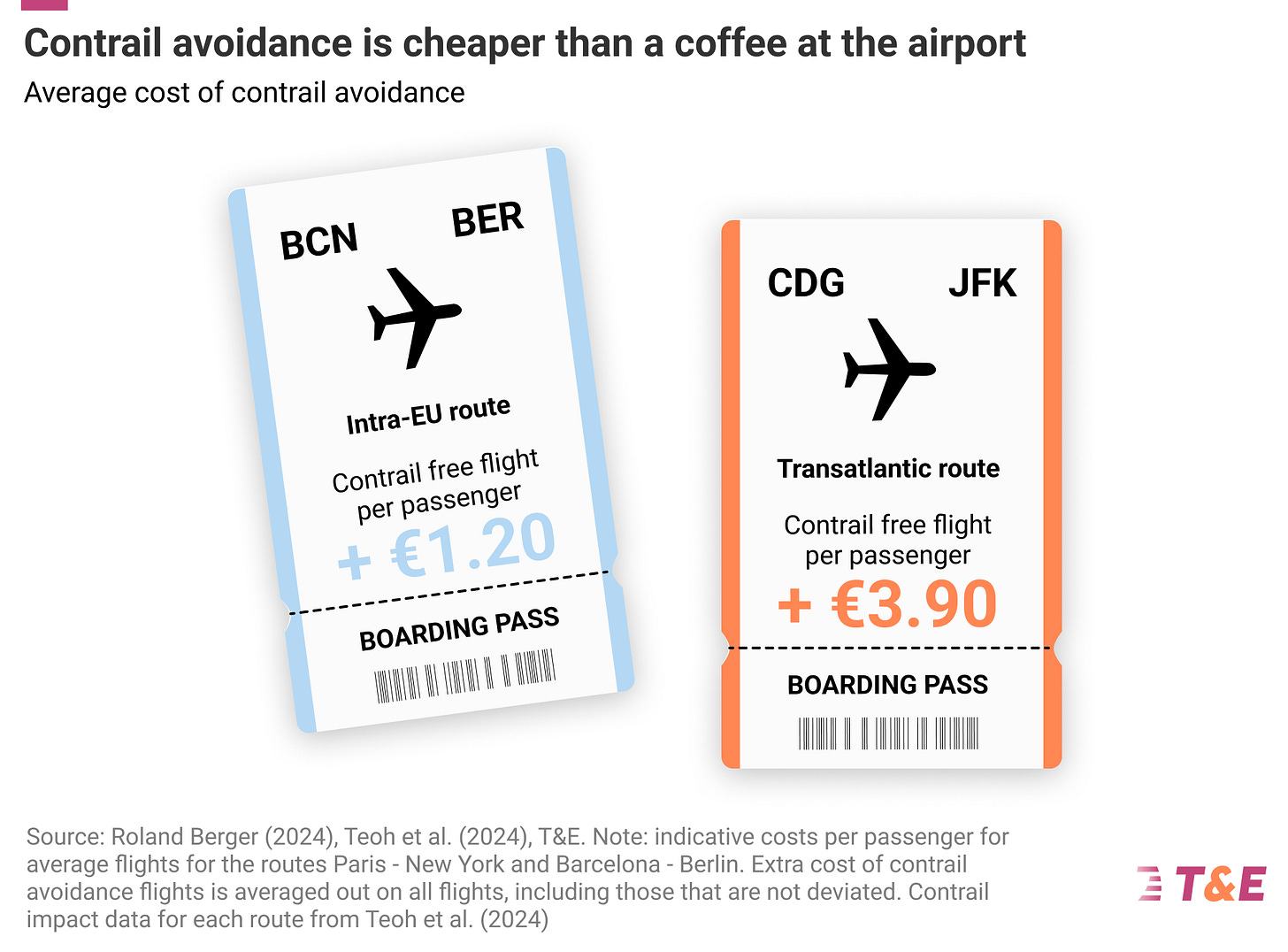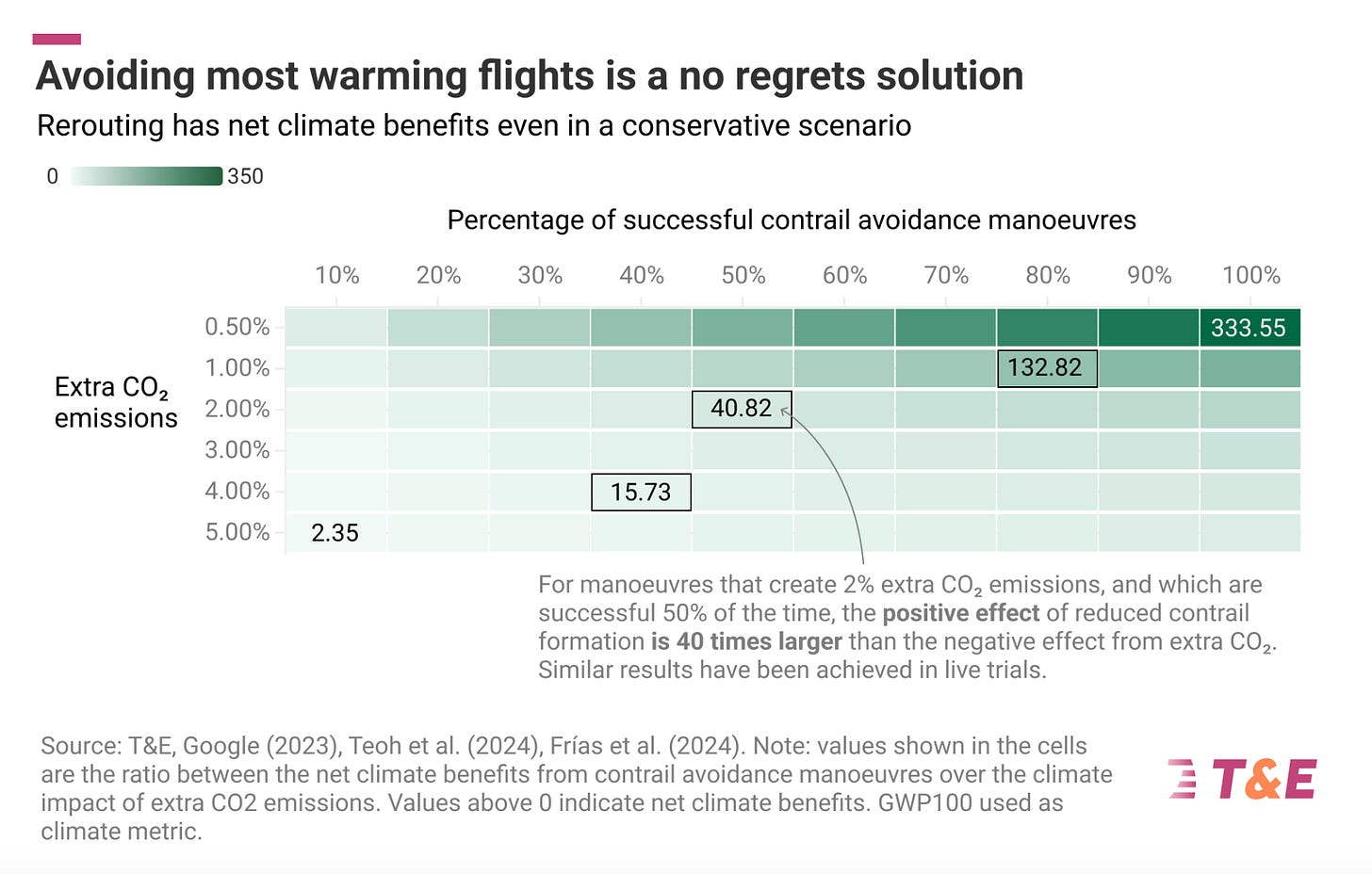Contrail Avoidance is Cheaper Than a Cup of Airport Coffee
New study from T&E puts a price on your future contrail avoiding plane ticket - and it's not a lot
✅ If you could cut the climate impact of your transatlantic flight in half by paying $3.90 extra - less than a cup of coffee at the airport - would you do it?
According to a new study from Transport & Environment (T&E) coming out today, all expenses related to avoiding the climate warming contrails from jet planes will only cost passengers 1-4 euros extra per ticket when fully implemented.
In the report, T&E analyzes the climate impact and costs of contrail avoidance using the latest research and calculating with conservative values.
✈️ One argument that we have heard repeatedly in the last couple of years is that we should not spend any extra fuel flying around the contrail areas because that extra fuel might have a larger climate impact than the contrails we avoid making. It is, of course, important that the climate savings from contrail avoidance are larger than the climate impact from the CO2 emissions from extra fuel, but this report calls contrail avoidance a “no-regret solution.” When we target only the most warming flights, the climate benefits of reducing contrails could be at least 15 times larger than the impact of the CO₂ emissions from extra fuel burn - and again that is using conservative values.
✈️ The above graphic shows how concentrated a problem contrail warming is. If we have one hundred flights, only three of them create 80% of the warming. The rest of the warming comes from 14 flights that just make a little bit of contrail warming each. 7 out of the 100 flights create contrails that have a climate cooling effect - there is no need to touch those flights - while three quarters of all flights (76%) create neither cooling nor warming contrails. So to address the vast majority of warming we just need to reroute 3% of all flights.
✈️ Even if the prediction models are wrong nine out of ten times (telling a pilot to spend extra fuel flying around an area that would not have created contrails had he just continued through it) and the extra fuel burn is 5%, contrail avoidance is stil 2.35 times better for the climate. In a more likely scenario, the prediction models are accurate 50% of the time and the extra fuel burn is 2% which makes contrail avoidance 40 times better for the climate. These are significant climate savings for very little money and another reason for working to fast-forward adoption of contrail management.
In short: If we target the 80% most warming contrails and keep extra fuel use under 5%, contrail avoidance is good for the climate - even if the prediction models are horribly wrong (nine out of ten times).
Don’t let perfect be the enemy of good.
Today was Contrail Day at COP29 in Baku, Azerbaijan
Fresh of the press: The first ever contrail event at COP - the most significant climate meeting of the year - happened today in Baku at COP29 (see event page here).
“Not Just Carbon: Why the World Needs Climate Action on Contrails” took place on November 13, 2024, in the Green Zone. From Matteo Mirolo’s LinkedIn post:
“Today, we had an excellent discussion hosted by Cambridge Institute for Sustainability Leadership (CISL), Aviation Impact Accelerator (AIA) and Reviate by Breakthrough Energy on contrail science, system change and the roles the aviation industry, corporates, policymakers, and AI should play in turning contrail research into climate action.”
Take Photos of Contrails and Win a Trip to Europe
The E-Contrail project and Breakthrough Energy (contrails) are collaborating to collect more ground observation photos of contrails for research.
Therefore, E-Contrail has launched a competition, which is very simple: Sign up on this webpage, download the contrail observer app (Apple, Android), and take photos with the app of contrails in the sky. That’s all you need to enter the competition and help researchers advance contrail climate science ❤️🔥.
🏆 The prize for the best contrail photo is a trip to “Europe" - the E-Contrail folks have not yet decided where to hold their next meeting - it could be Madrid, Brussels, you name it. This is a great way to help the climate. Thank you! 🙏
Go to Blue Lines’ educational website to explore contrails in depth.
(As regular readers of the Blue Lines newsletter will know, contrails are the wispy white stripes that airplanes sometimes leave behind in the sky (made from water vapor and engine soot). Some of these condensation trails can spread out and become high-altitude ice clouds (cirrus), which reflect some of the sun’s energy back into space but also trap outgoing energy in the atmosphere, resulting in a net heating of our planet equivalent to 1-2% of human-induced global warming. However, we can relatively easily avoid most warming contrails by flying around the contrail-prone areas in the atmosphere. This climate solution – often called contrail management or contrail avoidance – is what Blue Lines promotes and wants to see spread worldwide.)
See you soon.
Joachim Majholm,
Blue Lines









